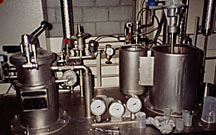Part 5
Go back to Part 4
By the end of January 1994 Albin Kälin had eliminated polyester from Climatex,
producing a new blend of ramie and wool that preserved the fabric's
moisture-wicking properties.
He called this new fabric Climatex Lifecycle. Using this fabric This meant that the route
to producing a compostable fabric seemed easier than using material that reclaimed and
reused polyester and other technical nutrients.
By the end of January, Kälin had sent Braungart all
of the security data sheets and production details pertaining to the
chemicals and dye substances used in the
manufacturing of Climatex Lifecycle. The team
hoped that this information would be enough for Braungart to make recommendations
on how to proceed by the end of February 1994. They wanted Braungart's
examination to be totally complete by the end of March 1994.
 At the beginning of March 1994, Braungart had some bad news. The chemicals
used in the dye materials did not meet the design protocol. Furthermore, questions involved
in the manufacture of the dye chemicals could not be answered by examining the
security data sheets, even though they had passed the OEKO-Tex standards.
DesignTex's next Portfolio Collection, McDonough's
fractal patterns and design protocols, and Kälin's and Rohner's next generation
of Climatex, depended on Braungart's ability to gain access to
the manufacturing processes of the dye suppliers, which meant the dye
suppliers had to open their books to Braungart. Kälin contacted Rohner's
dye suppliers and asked them to cooperate with Braungart's inspection and answer his
questions. By the end of March, however, such cooperation was not forthcoming.
Braungart contacted over 60 chemical companies worldwide, none of which had agreed to open
their books for his inspection.
At the beginning of March 1994, Braungart had some bad news. The chemicals
used in the dye materials did not meet the design protocol. Furthermore, questions involved
in the manufacture of the dye chemicals could not be answered by examining the
security data sheets, even though they had passed the OEKO-Tex standards.
DesignTex's next Portfolio Collection, McDonough's
fractal patterns and design protocols, and Kälin's and Rohner's next generation
of Climatex, depended on Braungart's ability to gain access to
the manufacturing processes of the dye suppliers, which meant the dye
suppliers had to open their books to Braungart. Kälin contacted Rohner's
dye suppliers and asked them to cooperate with Braungart's inspection and answer his
questions. By the end of March, however, such cooperation was not forthcoming.
Braungart contacted over 60 chemical companies worldwide, none of which had agreed to open
their books for his inspection.
Another concern was project cost. Someone needed to pay Braungart and the
EPEA as he studied the manufacturing processes. Kälin agreed to hire
Braungart and the EPEA, because Rohner expected to acquire the patent
rights for the next generation of Climatex. By the end of April, however, Braungart
had already expended the funds Rohner had provided and needed an extension.
Rohner was willing to consider an additional payment,
but only after the product had been introduced into the marketplace. None of the team was
sure how much more money Braungart would require.
Lyons reflected on the situation. DesignTex had made a
large commitment to this project, hoping it would propel the firm into the lead of
the commercial-fabric market. It had already been three years
since DesignTex launched the first Portfolio Collection, and she
was aware of the pressure to get a product out the door. Waiting on Braungart to gain access risked
the whole project
and would dramatically increase its cost, even if he succeeded. On the
other hand, perhaps it would be better to relax McDonough's
and Braungart's standards a little and test the results of the manufacturing
process without inspecting the dye suppliers' dye-production processes.
After all, Climatex Lifecycle was already a major improvement over currently available
designs. On the other hand, this whole project was about
making a breakthrough in environmental design, and it was
not clear that anything short of the McDonough/Braungart approach would represent
a sufficient leap forward.
 At the beginning of March 1994, Braungart had some bad news. The chemicals
used in the dye materials did not meet the design protocol. Furthermore, questions involved
in the manufacture of the dye chemicals could not be answered by examining the
security data sheets, even though they had passed the OEKO-Tex standards.
DesignTex's next Portfolio Collection, McDonough's
fractal patterns and design protocols, and Kälin's and Rohner's next generation
of Climatex, depended on Braungart's ability to gain access to
the manufacturing processes of the dye suppliers, which meant the dye
suppliers had to open their books to Braungart. Kälin contacted Rohner's
dye suppliers and asked them to cooperate with Braungart's inspection and answer his
questions. By the end of March, however, such cooperation was not forthcoming.
Braungart contacted over 60 chemical companies worldwide, none of which had agreed to open
their books for his inspection.
At the beginning of March 1994, Braungart had some bad news. The chemicals
used in the dye materials did not meet the design protocol. Furthermore, questions involved
in the manufacture of the dye chemicals could not be answered by examining the
security data sheets, even though they had passed the OEKO-Tex standards.
DesignTex's next Portfolio Collection, McDonough's
fractal patterns and design protocols, and Kälin's and Rohner's next generation
of Climatex, depended on Braungart's ability to gain access to
the manufacturing processes of the dye suppliers, which meant the dye
suppliers had to open their books to Braungart. Kälin contacted Rohner's
dye suppliers and asked them to cooperate with Braungart's inspection and answer his
questions. By the end of March, however, such cooperation was not forthcoming.
Braungart contacted over 60 chemical companies worldwide, none of which had agreed to open
their books for his inspection.